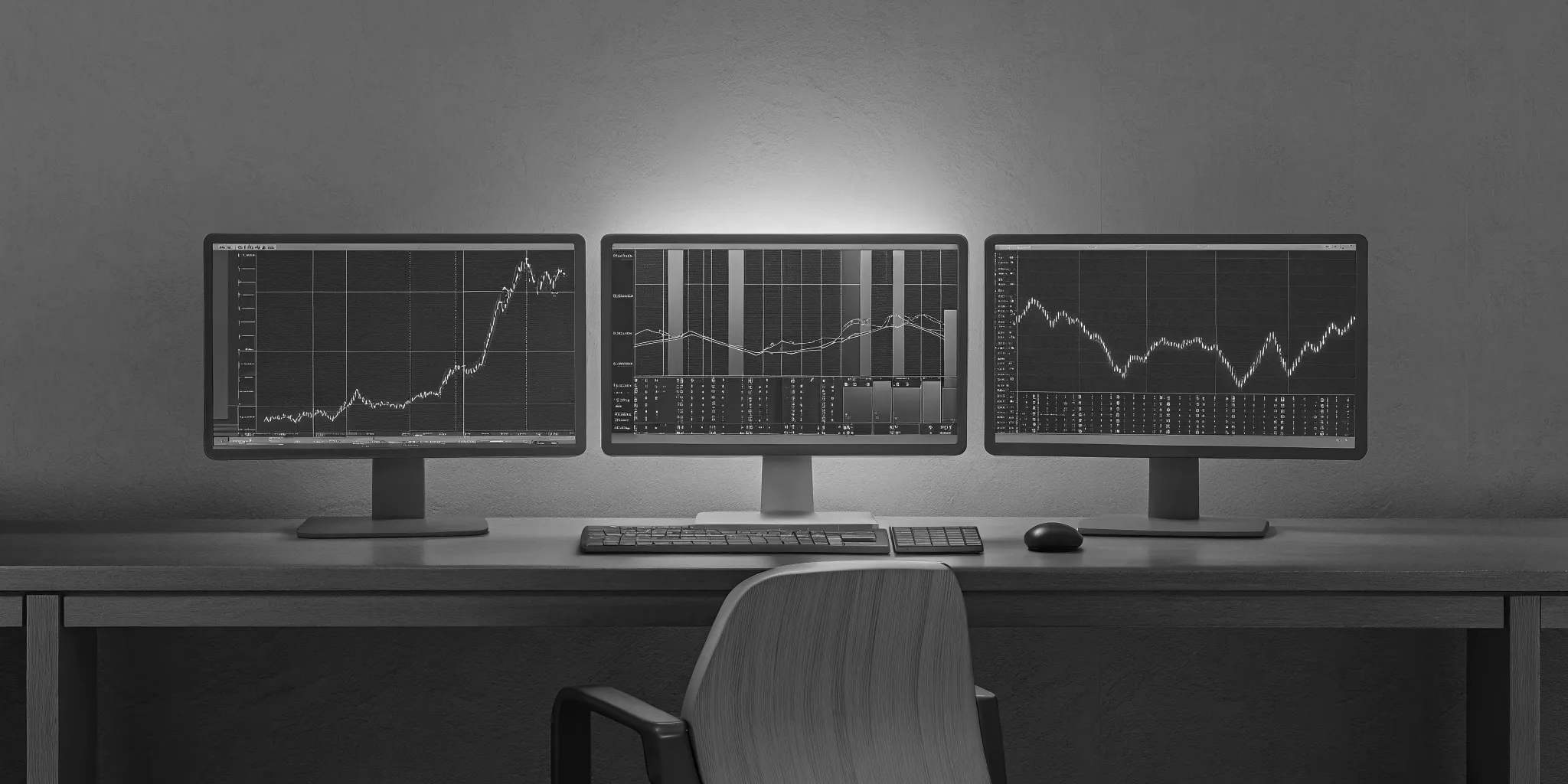The world of finance is transforming at an unprecedented rate, and those who embrace technology are reaping the rewards. Tech-savvy traders are no longer relying solely on gut feelings and traditional methods. They’re harnessing the power of AI, machine learning, and advanced analytics to analyze vast amounts of data, identify profitable opportunities, and execute trades with lightning-fast speed. This shift towards data-driven decision-making is revolutionizing the trading landscape, and in this exploration, we’ll delve into the key elements that set tech-savvy traders apart.
Key Takeaways
- Tech-savvy traders blend market knowledge with cutting-edge tools: Mastering today’s markets requires data-driven insights and the right software, from advanced charting to AI-powered platforms. Don’t just react—anticipate.
- AI empowers, but doesn’t replace, your trading expertise: Leverage AI for pattern recognition, news analysis, and risk management, but remember that technology enhances, not replaces, your market understanding. Balance automation with human oversight.
- Continuous learning and adaptation are essential: Markets constantly evolve. Stay updated on new technologies, refine your strategies, and never stop learning. Adaptability is key to long-term success.
What Defines a Tech-Savvy Trader?
Tech-savvy traders aren’t just clicking buttons; they’re blending traditional market knowledge with cutting-edge technology. They understand that today’s markets demand more than just gut feelings—they require data-driven insights and lightning-fast execution. Think of them as the cyborgs of Wall Street, merging human intuition with the raw processing power of computers. So, what exactly sets them apart?
It starts with a thirst for data. Tech-savvy traders use advanced software to analyze vast amounts of financial information, spotting trends and patterns that would be invisible to the naked eye. They’re fluent in the language of algorithms and artificial intelligence (AI), using these tools to predict market movements with remarkable accuracy. They’re not afraid to code their own indicators or build custom trading bots, constantly refining their strategies for optimal performance. AI-powered platforms use advanced algorithms to analyze data, identify opportunities, and execute trades with precision.
But it’s not just about crunching numbers. Tech-savvy traders also understand the importance of the right tools. They explore AI platforms offering automated and smart trading solutions, seeking out platforms with robust features, customizable interfaces, and seamless integration with other services. They’re always on the lookout for the next innovation, whether it’s a new charting software or a sophisticated risk management tool. They know that in the fast-paced world of finance, staying ahead of the curve is essential for success. This means embracing AI-powered platforms that execute trades with precision and speed. They’re constantly learning, adapting, and evolving their approach, always seeking an edge in the market.
Essential Trading Tools and Platforms
Tech-savvy traders rely on a suite of tools to stay ahead. These range from advanced charting software to AI-powered platforms that automate complex strategies. Let’s explore the essentials.
Advanced Charting & Analysis Software
Beyond basic price charts, advanced charting software offers technical indicators, drawing tools, and customizable dashboards. TrendSpider lets you automate trendline detection and backtest strategies, saving you hours of manual work. These tools empower you to visualize market data, spot potential opportunities, and fine-tune your entries and exits.
Algorithmic Trading Platforms
For automated trading, algorithmic platforms are key. These platforms execute trades based on pre-defined rules, removing emotional biases. Tickeron uses AI-driven tools to analyze markets and generate trade ideas, helping you make data-driven decisions. This level of automation is crucial for high-frequency trading and complex strategies.
AI-Powered Trading Solutions
AI is transforming trading by processing vast amounts of data and uncovering hidden patterns. Machine learning algorithms analyze historical data, market trends, and even external factors like news sentiment. Pure Financial Academy offers more insights into how AI is shaping the future of investing. Platforms like FN Capital leverage AI to execute trades with precision and manage risk dynamically. This data-driven approach helps traders make informed decisions and adapt to changing market conditions.
Top Platforms for Tech-Savvy Traders
The right trading platform is essential for executing your strategies effectively. Here are a few popular choices:
FN Capital
FN Capital offers a fully automated, AI-powered trading solution. Their proprietary FAST AI algorithm focuses on the EUR/USD pair, providing consistent returns and managing risk with their Dynamic Algorithmic Risk Tool (DART). For those seeking a hands-off approach to forex trading, FN Capital is worth exploring.
MetaTrader 5
MetaTrader 5 (MT5) is a widely used platform known for its advanced charting, algorithmic trading capabilities, and a vast library of custom indicators. It’s a versatile choice for traders of all levels. Eastgate Software highlights MT5 as a top AI trading platform.
TradingView
TradingView combines powerful charting with a social networking aspect. Traders can share ideas, discuss strategies, and learn from each other. TechBullion recognizes TradingView for its user-friendly interface and social features.
NinjaTrader
NinjaTrader is favored by active traders for its advanced charting, order flow analysis, and strategy backtesting capabilities. It’s a robust platform for those who prefer a hands-on approach. ValueWalk lists NinjaTrader among the best AI trading platforms.
Interactive Brokers
Interactive Brokers offers a comprehensive platform with a wide range of instruments, advanced order types, and tools for both novice and experienced traders. They also provide algorithmic trading options for automated strategies. MaxeAI recommends Interactive Brokers for its comprehensive tools.
Quantopian
Quantopian is a platform specifically designed for algorithmic trading. Users can develop, backtest, and even deploy their own trading algorithms using historical data. TechBullion includes Quantopian in its list of top AI platforms.
Alpaca
Alpaca is a developer-friendly platform with a commission-free trading model. It’s a great choice for tech-savvy traders who want to build and automate their own strategies using APIs. MaxeAI highlights Alpaca as an excellent choice for tech-savvy traders.
QuantConnect
QuantConnect offers a cloud-based algorithmic trading platform. Users can design, backtest, and deploy strategies using various programming languages, making it a flexible option for those comfortable with coding. TechBullion features QuantConnect as a cloud-based option for algorithmic trading.
How Technology Improves Trading Strategies
Technology has revolutionized trading, giving tech-savvy traders powerful tools and strategies to master the markets. Let’s explore how these advancements enhance every aspect of the trading process.
Analyze Data and Make Decisions in Real Time
In today’s fast-moving markets, real-time data analysis is essential. AI and machine learning algorithms process massive amounts of financial data instantly, uncovering hidden patterns and generating predictive insights. By analyzing historical data, current market trends, and even external factors like news events, these tools empower traders to make informed decisions much faster than any human could. This speed and precision can mean the difference between seizing an opportunity and watching it slip away.
Automate Trade Execution
Automated trading platforms execute trades based on predefined rules and algorithms, removing emotional biases and ensuring consistent execution. These platforms offer smart solutions for investors to optimize their portfolios. Set your strategy and let the platform handle the execution, freeing you to refine your approach and explore new opportunities. Automation saves time and enforces discipline, preventing impulsive trades driven by fear or greed.
Manage Risk with AI
Risk management is paramount in trading, and AI provides sophisticated tools to mitigate potential losses. AI-driven platforms use advanced algorithms to analyze market conditions, identify potential risks, and adjust trading parameters. These platforms combine algorithms and real-time data to help traders make decisions and manage trades efficiently. Features like real-time monitoring, automated stop-loss orders, and dynamic position sizing help protect your capital during market volatility. This allows you to confidently navigate market fluctuations, knowing your investments are protected by intelligent risk management tools.
Use High-Frequency Trading
High-frequency trading (HFT) uses powerful computers to execute many trades extremely fast. While typically associated with institutional investors, platforms like Tickeron make these strategies accessible to individual traders. AI-powered tools within these platforms analyze market data, identify fleeting opportunities, and execute trades with speed and precision. This allows traders to capitalize on tiny market fluctuations that would be impossible to exploit manually. This speed and efficiency can give you a significant edge in fast-paced markets.
Key Features to Look For
When evaluating trading platforms and software, keep an eye out for these essential features that can significantly enhance your trading experience.
Customizable Interfaces & Dashboards
A customizable interface is key for any serious trader. You should be able to tailor your trading dashboard to display the information you need, how you need it. Think personalized watchlists, custom chart layouts, and configurable alerts. This level of personalization streamlines your workflow and keeps you focused on the important elements of your trading strategy. Tickeron is one platform offering AI-powered tools that analyze market data and provide personalized trade ideas.
API Integration
For tech-savvy traders, API integration is a must-have. A robust API allows you to connect your trading platform to other software, opening doors to automating tasks, backtesting strategies, and even building your own custom trading algorithms. Platforms like Alpaca are excellent choices for developers and tech-savvy traders who want this level of control and flexibility.
Mobile Trading
The ability to trade from anywhere is essential in today’s fast-moving markets. A solid mobile trading app lets you monitor your positions, execute trades, and stay informed about market events, all from your smartphone or tablet. Many AI platforms offer automated and smart trading solutions packed with mobile features.
Advanced Risk Management Tools
Protecting your capital is paramount, so look for platforms that offer advanced risk management tools. Features like stop-loss orders, trailing stops, and position sizing calculators can help you mitigate potential losses and manage your risk effectively. AI-driven trading algorithms leverage advanced techniques like machine learning and predictive analytics to enhance decision-making and manage risk.
Backtesting & Strategy Optimization
Before deploying any trading strategy, it’s crucial to test its effectiveness. Backtesting allows you to simulate your strategy against historical market data, giving you valuable insights into its potential performance. Look for platforms with robust backtesting capabilities and optimization tools to refine your approach before risking real capital. TrendSpider is one example of a platform with powerful tools for creating and testing AI-powered strategies.
The Role of AI in Trading
AI is changing how we trade, offering powerful tools for informed decision-making. From recognizing patterns to predicting market movements, AI is no longer a futuristic concept but a present-day reality for tech-savvy traders. Let’s explore some key applications:
Use Machine Learning for Pattern Recognition
AI excels at processing massive datasets, something impossible for human traders. Machine learning algorithms sift through historical market data, identifying subtle patterns and trends that often go unnoticed. This allows traders to anticipate potential market movements and make data-driven decisions, minimizing emotional biases. These algorithms adapt and refine their analysis as new data becomes available, constantly improving their predictive accuracy. For more information, check out this article on AI in trading.
Use Natural Language Processing for News Analysis
Staying on top of market news is crucial for any trader. AI-powered tools leverage natural language processing (NLP) to analyze news articles, social media posts, and other textual data sources in real time. This helps traders gauge market sentiment and understand the potential impact of news events on asset prices. NLP can also identify emerging trends and shifts in public opinion, providing valuable insights for strategic decision-making. Learn more about how AI-based platforms are using these technologies.
Use Predictive Analytics for Market Forecasting
Predictive analytics takes AI’s capabilities a step further by forecasting potential market movements. By analyzing historical data, current market conditions, and various economic indicators, AI algorithms can generate predictions about future price movements. While no prediction is foolproof, these insights can help traders identify potential opportunities and manage risk more effectively. This article on smart trading solutions offers additional insights.
Use Sentiment Analysis for Social Media Trends
Social media has become a powerful force in shaping market sentiment. AI-powered sentiment analysis tools track social media conversations, gauge public opinion towards specific assets, and identify potential market-moving trends. This real-time insight into collective market psychology can be invaluable for short-term traders and those interested in understanding the drivers behind sudden price fluctuations. Explore some common misconceptions about AI in trading to learn more.
Common Pitfalls to Avoid
Even with the best tools and tech, trading has inherent risks. Being tech-savvy doesn’t eliminate the need for caution and a well-rounded approach. Here are a few common traps to watch out for:
Over-Reliance on Technology
It’s tempting to think technology can solve everything. While platforms like FN Capital offer powerful AI-driven insights, relying solely on algorithms without understanding the underlying market dynamics can be risky. Remember that technology is a tool to enhance your decision-making process, not replace it entirely. Don’t neglect technical analysis and developing your own market understanding.
Neglecting Fundamental Analysis
Tech-savvy traders sometimes focus heavily on quantitative data and algorithms, overlooking the importance of fundamental analysis. Understanding the broader economic factors, company performance, and industry trends that influence asset prices is crucial for long-term success. A balanced approach that combines technical prowess with a fundamental understanding is key.
Ignoring Cybersecurity Risks
As you integrate more technology into your trading, you also increase your vulnerability to cyberattacks. Protecting your trading accounts, personal information, and API keys is paramount. Use strong passwords, enable two-factor authentication, and be wary of phishing scams. Regularly update your software and stay informed about the latest cybersecurity best practices for traders.
Failing to Adapt to Market Changes
Markets are constantly evolving. What works today might not work tomorrow. A tech-savvy trader needs to be adaptable and willing to adjust their strategies as market conditions change. Continuously learning, backtesting your algorithms, and staying informed about market trends are essential for navigating these shifts effectively. Don’t be afraid to refine your approach as needed.
Emotional Trading
Even with advanced technology, emotions can still influence trading decisions. Fear, greed, and FOMO (fear of missing out) can lead to impulsive trades and poor risk management. Having a clear trading plan, setting realistic expectations, and practicing discipline are crucial for avoiding emotional pitfalls. Remember, consistent profitability comes from making rational decisions, not chasing quick wins or reacting to market hype.
Choose the Right Trading App
Finding the right trading app is like finding the perfect pair of running shoes—it needs to fit your needs and style. Whether you’re a seasoned trader or just starting out, the right tech can make all the difference. Here’s what to consider:
User Interface and Experience
A cluttered or confusing interface can throw off even the most experienced trader. Look for an app with a clean, intuitive design. As Alltech Magazine points out in their review of top forex trading apps, speed and precision are key for tech-savvy traders. This means finding a platform that lets you execute trades quickly and efficiently. Think streamlined dashboards, customizable layouts, and easy-to-read charts.
Features and Tools
AI is transforming the investment landscape, and platforms offering smart trading solutions often come with a suite of powerful features. Do you need advanced charting tools? Automated trading capabilities? AI-driven insights? Consider what features will actually support your trading strategy. Look for an app that delivers. For example, platforms like Tickeron offer AI-powered tools that analyze market data and even suggest trade ideas.
Security Measures
Security is paramount when it comes to your financial data. Look for apps with robust security measures like two-factor authentication and encryption. A reputable platform will prioritize protecting your information and funds. AI trading platforms often use advanced algorithms not just for trading, but also for enhanced security protocols.
Integrations
Seamless integration with other tools can significantly improve your workflow. Consider whether the app integrates with your preferred charting software, news feeds, or other analytical tools. For developers and tech-savvy traders, platforms like Alpaca are a great choice, offering extensive API access for building and automating custom strategies.
Customer Support and Community
Even with the best technology, questions or issues can arise. Reliable customer support is essential. Look for an app that offers responsive support channels, whether it’s 24/7 live chat, email, or a helpful online community. 24/7 customer support can be a lifesaver when you need quick assistance. A strong community forum can also be a valuable resource for learning from other traders.
Build a Tech-Savvy Trading Strategy
A tech-savvy trading strategy blends traditional market analysis with the power of today’s technology. It’s not about replacing your knowledge, but enhancing it. Here’s how to build a robust, tech-driven approach:
Combine Technical Analysis with AI Insights
Technical analysis remains a cornerstone of trading. Support and resistance levels, trendlines, and chart patterns offer valuable clues about potential price movements. AI can supercharge this analysis. AI excels at processing massive datasets and spotting subtle correlations that might escape a human trader. Use AI-driven tools to identify emerging trends, confirm your technical analysis, and fine-tune entry and exit points. Think of AI as your research assistant, highlighting key information and helping you make more informed decisions. For more insights into how AI is shaping the future of investing, check out this article on AI in trading.
Backtest and Optimize Algorithms
If you’re incorporating algorithmic trading, backtesting is crucial. A solid AI trading platform will let you test your algorithms against historical data, simulating real-market conditions. This helps you identify potential flaws and optimize your strategies before risking real capital. Remember, past performance isn’t a guarantee of future success, but thorough backtesting can significantly improve your odds. Look for platforms that offer robust backtesting features, including customizable parameters and detailed performance reports. Explore the top AI-based trading platforms to find the right fit for your needs.
Learn and Adapt Continuously
Markets are constantly evolving, so continuous learning is essential for any trader. Stay updated on new technologies, trading strategies, and market trends. Regularly review your trading performance, identify areas for improvement, and adjust your approach accordingly. Even seasoned traders can fall prey to common pitfalls, so ongoing education is key. Embrace lifelong learning as part of your trading journey. This article on common trading mistakes offers valuable insights to help you avoid common errors.
Balance Automation with Human Oversight
While automation can streamline your trading process, don’t completely relinquish control. AI is a powerful tool, but it’s not infallible. Maintain a balance between automated execution and human oversight. Monitor your algorithms, review their performance, and be prepared to intervene if necessary. Market conditions can change rapidly, and sometimes your intuition and experience will be your best assets. Use technology to enhance your decision-making, not replace it entirely. This article on common misconceptions about AI in trading provides a helpful perspective on integrating AI effectively.
The Future of Tech-Driven Trading
The trading landscape is evolving rapidly, thanks to groundbreaking technologies that are changing how we analyze markets, execute trades, and manage risk. This section explores emerging trends, regulatory considerations, and the potential market impacts of this tech-driven transformation.
Emerging Technologies
Artificial intelligence (AI) and machine learning (ML) are transforming the trading sector. AI excels at processing vast amounts of financial data in real time, uncovering patterns, and generating predictions with remarkable accuracy. Machine learning algorithms analyze historical data, current market trends, and even external factors like news sentiment, empowering traders to make informed decisions. Automated trading platforms are becoming increasingly sophisticated, offering smart solutions that streamline investment strategies and optimize portfolios. It’s crucial to understand the capabilities and limitations of these powerful tools.
Regulatory Considerations for AI-Powered Trading
The rapid growth of AI in trading presents new ethical and regulatory questions. As AI systems become more autonomous, discussions around accountability, transparency, and potential biases within algorithms are essential. The ethical implications of AI-driven trading are a subject of ongoing discussion, and regulators are working to create frameworks that ensure responsible use of these tools. Staying informed about the latest guidelines and best practices is crucial for navigating this evolving regulatory landscape.
Potential Market Impacts
Widespread adoption of AI-powered trading has the potential to reshape market dynamics. AI trading platforms use advanced algorithms to analyze data, identify opportunities, and execute trades with speed and precision. This can create increased market efficiency, tighter spreads, and lower transaction costs. However, it also raises questions about potential market volatility and the risks of unforeseen consequences from complex, interconnected AI systems. As we move toward a more data-driven and automated trading environment, understanding these potential market impacts is important for both individual traders and institutions. Balancing the benefits of AI with robust risk management and human oversight will be key to navigating the future of tech-driven trading.
Related Articles
- Algorithmic Trading Success Stories & Winning Strategies – FN Capital
- Top Institutional Trading Platforms: A Complete Guide – FN Capital
- AI vs. Human Trading Performance: An Objective Comparison – FN Capital
- AlgoTrade: The Ultimate Guide to Algorithmic Trading – FN Capital
- A Practical Guide to Buying Algorithmic Trading Software – FN Capital
Frequently Asked Questions

What’s the biggest advantage of using AI in trading? AI can process vast amounts of data and identify subtle market patterns much faster than any human. This speed and analytical power allows for more informed decisions, optimized entries and exits, and potentially greater profitability. It also removes emotional biases, leading to more disciplined trading.
Is coding experience necessary to use AI trading platforms? Not necessarily. While some platforms cater to experienced coders who want to build their own algorithms, many user-friendly platforms offer pre-built AI strategies and intuitive interfaces. These platforms allow you to leverage the power of AI without needing extensive programming knowledge. However, even a basic understanding of coding can be beneficial for customizing and optimizing your AI-driven strategies.
What are the risks of relying too heavily on automated trading systems? While automation offers many advantages, over-reliance can be risky. Markets are complex and constantly changing, and no algorithm can predict the future with 100% accuracy. Blindly following automated signals without understanding the underlying market dynamics can lead to significant losses, especially during unexpected market events. It’s essential to maintain human oversight, monitor your automated systems, and be prepared to adjust your strategies as needed.
How can I integrate AI into my existing trading strategy? Start by identifying areas where AI can enhance your current approach. Are you struggling with identifying promising setups? Do you want to improve your risk management? Explore AI-powered tools that address your specific needs. Many platforms offer features like automated pattern recognition, predictive analytics, and dynamic risk management. Begin by incorporating one or two AI tools into your workflow and gradually expand your use as you become more comfortable.
What are the most important things to consider when choosing an AI trading platform? Focus on factors that align with your trading style and experience level. Consider the platform’s user interface, available features, security measures, and integration options. If you’re a beginner, look for a user-friendly platform with educational resources and pre-built AI strategies. More experienced traders might prioritize advanced charting tools, API access for custom integrations, and robust backtesting capabilities. Also, research the platform’s reputation, customer support, and pricing structure to ensure it’s a good fit for your needs.





